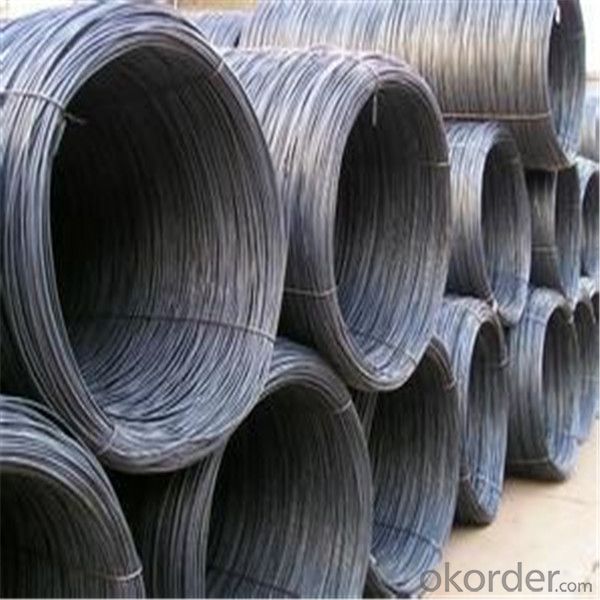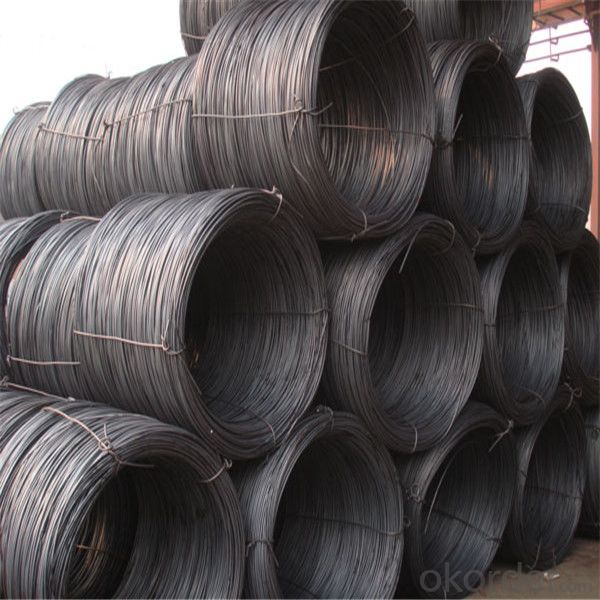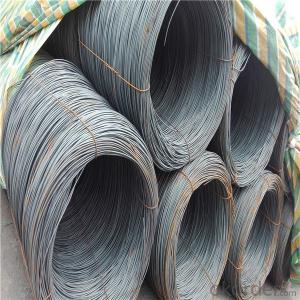Wire rod with hot price 5.5mm-12mm different grade
- Loading Port:
- Guangzhou
- Payment Terms:
- TT OR LC
- Min Order Qty:
- 50 m.t.
- Supply Capability:
- 19710 m.t./month
OKorder Service Pledge
OKorder Financial Service
You Might Also Like
Item specifice
Produced from billets at the rolling mill, wire rod is the basis of all steel wire, rope and fencing products.
The most important characteristic in determining wire rod’s end use is its drawability. Common low carbon
wire rod is used for nails, small shaped products, barbed wires, various wire nettings, steel chains, and other
applications. High Carbon wire rod uses include steel tire cords for automobiles, conveyor belts, and pressure
hoses. Other applications include bolts, nuts, and machine parts, as well as compression, tension and torsion
springs
Our service:
(1) We cooperate with famous factories with advanced equipment and well trained workers.
(2) We can provide factory price with trading company service.
(3) We continuously work on the improvement of our processes, guaranteeing
consistently high standards of quality to keep none compensation.
(4) We guarantee 24 hours response and 48 hours solution providing service.
(5) We accept small order quantity before formal cooperation.
(6) We deliver the agreed quality at the agreed time, reacting to changes in
customer wishes in a flexible way.
(7) Due to our volume and selling power, we have excellent freight rates with
shipping lines.
(8) We strive to always be fair and honest in our dealings with customers.
(9) We strive to work together with customers to achieve much more than we can
achieve alone.
(10) Through our passion and commitment we aim to be a market leader in all our
key markets. To maintain our position as market leader we must continue to add
value in all that we do.
Product Description :
Standard | AISI, ASTM, BS, DIN, GB, JIS |
Material/steel grade | Q195-Q235,SAE1006B,SAE1006CR, SAE1008B, SAE1008CR, SAE1010B, SAE1018B, or according to customers requirements |
Wire Gauge | 5.5-12mm |
Coil weight | 1.8-2.1mts |
MOQ | 25MT |
Delivery Time | 15-30 days after receipt of L/C or deposit by T/T |
Packing | In coil and load in container, if large quantity, by bulk vessel; Can be packed as customers' special requirements |
Payment terms | 1).100% irrevocable L/C at sight. 2).30% T/T prepaid and the balance against the copy of B/L. 3).30% T/T prepaid and the balance against L/C |
Application | widely used in machinery parts, manufacturing industry, electronics industry, metal tools and others |


Application :
Mainly used in building and construction as binding wire, tie wire and baling wire; also can be make
for wire mesh.
Packing :
Hot-rolled wire rod is held in a unit with at least four steel straps in the
transverse direction and transported and stored without further packaging.
Before
the steel strapping is applied, the wire rod must be sufficiently compressed.
The strapping is fixed in the transverse direction with a single circumferential
strap so that the strapping does not slip and cause the coil to come apart.


FAQ:
1.Q:Can you accept mixed order?
A: Yes, mixed acceptable .
2. Q: How can I buy CNBM products in my country?
A:Please send us an inquiry or email ,we will reply to you if there is distributor in your country
3. Q: Can we visit your factory?
A: Warmly welcome. Once we have your schedule, we will arrange the
professional sales team to follow up your case.
4. Q: How long does it take to get the product if i place an order?
A:With the process of your requirements,we will pack and deliver in 3
-7 days. If it is by sea shipment,it will take 15-45 days depending on different locations
- Q:How are steel wire rods used in the manufacturing of wire baskets for storage and organization?
- Steel wire rods are a crucial component in the manufacturing of wire baskets for storage and organization. These rods serve as the raw material for creating the wire mesh that forms the structure of the basket. Firstly, the steel wire rods are subjected to a series of processes such as cleaning, straightening, and cutting to ensure that they are of the desired length and free from any impurities. Once prepared, the rods are then fed into a machine known as a wire-drawing machine, where they are drawn through a series of dies to reduce their diameter to the desired size. This process also helps in increasing the tensile strength of the wire. Next, the wire rods are fed into a wire mesh machine, where they are woven together to form a sturdy mesh pattern. The size of the mesh can be customized according to the specifications of the wire basket being manufactured. This mesh is then cut into sheets of the required dimensions. The sheets of wire mesh are then shaped and welded together to create the basket's structure. The steel wire rods not only provide strength and stability to the basket but also ensure that it can withstand the weight of the items being stored and prevent any deformation or bending. Furthermore, the wire rods can be coated or treated with different finishes, such as galvanization or powder coating, to enhance their durability and resistance to corrosion. This ensures that the wire baskets can be used in various environments, including damp or corrosive conditions, without degrading or losing their functionality. In conclusion, steel wire rods play a vital role in the manufacturing of wire baskets for storage and organization. They serve as the primary material for creating the wire mesh, which forms the structure of the basket. The strength, durability, and customization options provided by steel wire rods make them an essential component in creating functional and long-lasting wire baskets.
- Q:How are steel wire rods used in the production of wire springs for various mechanical applications?
- Steel wire rods are used in the production of wire springs for various mechanical applications as they serve as the primary raw material. These rods undergo a series of manufacturing processes such as drawing, coiling, and heat treatment to transform them into wire springs. The wire rods provide the necessary strength, durability, and elasticity required for the springs to function effectively in applications such as automotive suspensions, industrial machinery, and furniture.
- Q:How is the surface quality of steel wire rod assessed?
- The surface quality of steel wire rod is typically assessed through visual inspection, using various methods such as magnification, lighting, and surface profiling techniques. Additionally, non-destructive testing methods like magnetic particle inspection or ultrasonic testing may be employed to detect any surface defects or irregularities.
- Q:What are the major innovations in steel wire rod production technology?
- Steel wire rod production technology has undergone several significant advancements in recent years, greatly enhancing the efficiency, quality, and sustainability of the production process. One notable innovation is the adoption of continuous casting technology. In the past, steel wire rods were produced using a batch process, where molten steel was poured into individual molds and allowed to solidify before being cut into rods. However, continuous casting enables a continuous flow of molten steel to solidify into long strands. This eliminates the need for individual molds and increases the speed and productivity of production. Another important advancement is the utilization of high-speed rolling mills. These mills are equipped with advanced technologies that allow for faster rolling speeds and higher production rates. By using high-speed rolling mills, the output of steel wire rods can be increased, while also improving the quality and consistency of the final product. Moreover, the development of automation and digital technologies has revolutionized steel wire rod production. Automated systems and robotics now control various stages of the production process, from raw material handling to finished product packaging. This reduces the risk of human error and enhances overall efficiency and productivity. Furthermore, there have been significant advancements in metallurgy, resulting in the production of stronger and more durable steel wire rods. Manufacturers can now produce rods with superior mechanical properties, such as higher tensile strength and improved resistance to corrosion and fatigue, through the use of advanced alloys and heat treatment processes. Lastly, there has been a growing emphasis on sustainability in steel wire rod production. The industry has made strides in energy-efficient technologies and waste reduction strategies, leading to significant improvements in environmental impact. Energy recovery systems and the incorporation of recycled materials in the production process have reduced energy consumption and minimized waste generation. In summary, major innovations in steel wire rod production technology encompass continuous casting, high-speed rolling mills, automation and digital technologies, advancements in metallurgy, and a heightened focus on sustainability. These innovations have not only enhanced the efficiency and quality of steel wire rod production but have also contributed to a more sustainable and environmentally friendly industry.
- Q:What are the common industry standards for steel wire rod?
- The common industry standards for steel wire rod include specifications such as the American Society for Testing and Materials (ASTM) A510, A510M, and A580, as well as the International Organization for Standardization (ISO) 16120 and 16124. These standards outline the requirements for the quality, dimensions, mechanical properties, and testing procedures of steel wire rod used in various industries.
- Q:What are the different types of steel wire rod coatings used for anti-corrosion properties?
- There are several types of steel wire rod coatings that are commonly used for their anti-corrosion properties. These coatings are applied to the surface of the steel wire rod to protect it from rust and corrosion in various environments. Some of the different types of steel wire rod coatings used for anti-corrosion properties include: 1. Zinc Coatings: Zinc coatings, such as galvanized coatings, are one of the most common types of coatings used for anti-corrosion purposes. These coatings provide a protective layer of zinc on the surface of the steel wire rod, which acts as a barrier against corrosion. Zinc coatings can be applied through hot-dip galvanizing or electroplating processes. 2. Aluminum Coatings: Aluminum coatings are another type of coating used for anti-corrosion properties. These coatings can be applied through processes such as hot-dip aluminizing or thermal spraying. Aluminum coatings provide a protective layer that prevents the steel wire rod from coming into contact with corrosive substances. 3. Epoxy Coatings: Epoxy coatings are a type of organic coating that is commonly used for anti-corrosion purposes. These coatings are applied as a liquid and then cured to form a hard and durable protective layer on the surface of the steel wire rod. Epoxy coatings provide excellent resistance against corrosion and can withstand exposure to harsh environments. 4. Polymer Coatings: Polymer coatings, such as polyethylene or polypropylene coatings, are often used for anti-corrosion properties. These coatings are typically applied through processes like extrusion or powder coating. Polymer coatings provide a protective layer that is resistant to chemicals, moisture, and other corrosive elements. 5. Ceramic Coatings: Ceramic coatings are known for their high resistance to corrosion and wear. These coatings are typically applied through thermal spraying or chemical vapor deposition processes. Ceramic coatings form a hard and dense layer on the surface of the steel wire rod, providing excellent protection against corrosion. It is important to choose the appropriate coating for a specific application based on factors such as the environment, operating conditions, and the level of corrosion resistance required. Each type of coating has its own advantages and limitations, so it is crucial to select the most suitable one to ensure long-term anti-corrosion protection for the steel wire rod.
- Q:How is steel wire rod used in the manufacturing of wire forms for jewelry findings?
- Steel wire rods are an essential component in the production of wire forms for jewelry findings. These rods are first drawn through a series of dies to reduce their diameter and achieve the desired thickness for the wire forms. The wire forms are then shaped and manipulated into various designs, such as clasps, jump rings, earring hooks, and pendants, using specialized tools and techniques. Steel wire rod provides the necessary strength, durability, and flexibility required for these jewelry findings, ensuring they can withstand everyday wear and tear while maintaining their shape and functionality.
- Q:Can steel wire rod be used for reinforcement purposes?
- Indeed, reinforcement purposes can be fulfilled by steel wire rod. Concrete structures, such as buildings, bridges, and highways, frequently rely on steel wire rod for reinforcement. This is due to the remarkable tensile strength of steel, enabling it to endure substantial loads and stresses. When incorporated into concrete, steel wire rod effectively heightens the overall strength and longevity of the structure. Additionally, it safeguards against cracking and enhances structural integrity. Given its exceptional mechanical properties and capacity to enhance the performance of concrete structures, the construction industry commonly utilizes steel wire rod for reinforcement objectives.
- Q:What are the different wire drawing lubricants used for steel wire rod?
- There are several different wire drawing lubricants used for steel wire rod, including soap-based lubricants, oil-based lubricants, and synthetic lubricants. Soap-based lubricants are commonly used for mild steel wire rod, as they provide good lubrication and cooling properties. Oil-based lubricants are often used for high carbon and alloy steel wire rod, as they offer better lubrication and reduce friction during the drawing process. Synthetic lubricants, such as water-based polymer lubricants, are also used to improve surface finish and reduce wear on the wire rod during drawing.
- Q:How is steel wire rod used in the manufacturing of wire forms for aerospace applications?
- To manufacture wire forms for aerospace applications, steel wire rod is essential. It serves as the starting material for wire drawing, which involves a series of processes to produce wire forms with specific dimensions and characteristics. The first step is to carefully select high-quality steel wire rod that meets the strict standards of the aerospace industry. This ensures that the wire forms will possess the necessary strength, durability, and corrosion resistance required for aerospace applications. Once the suitable steel wire rod is obtained, it is passed through a wire drawing machine with a series of dies. This process involves pulling the wire rod through progressively smaller dies, resulting in a reduction in diameter and an increase in length. Wire drawing not only shapes the wire but also refines its microstructure, leading to improved mechanical properties. Following wire drawing, the steel wire undergoes further processing based on the specific requirements of the wire forms. It may undergo additional treatments such as heat treatment, surface coating, or plating to enhance its performance and meet the rigorous aerospace industry standards. The wire forms produced from steel wire rod find extensive use in the aerospace sector. They are employed in the manufacturing of various aircraft components, including springs, fasteners, connectors, wire harnesses, and control cables. These wire forms play a vital role in ensuring the structural integrity, functionality, and safety of different aerospace systems. The utilization of steel wire rod in the production of wire forms for aerospace applications offers numerous advantages. Steel is renowned for its high strength-to-weight ratio, excellent fatigue resistance, and good electrical conductivity. These properties make steel wire forms ideal for withstanding the demanding conditions experienced in the aerospace industry. In conclusion, steel wire rod is an indispensable raw material in the manufacturing of wire forms for aerospace applications. Through processes like wire drawing and additional treatments, it is transformed into wire forms with the necessary properties to meet the stringent requirements of the aerospace industry. These wire forms significantly contribute to the structural integrity and functionality of various aerospace systems.
1. Manufacturer Overview |
|
|---|---|
| Location | |
| Year Established | |
| Annual Output Value | |
| Main Markets | |
| Company Certifications | |
2. Manufacturer Certificates |
|
|---|---|
| a) Certification Name | |
| Range | |
| Reference | |
| Validity Period | |
3. Manufacturer Capability |
|
|---|---|
| a)Trade Capacity | |
| Nearest Port | |
| Export Percentage | |
| No.of Employees in Trade Department | |
| Language Spoken: | |
| b)Factory Information | |
| Factory Size: | |
| No. of Production Lines | |
| Contract Manufacturing | |
| Product Price Range | |
Send your message to us
Wire rod with hot price 5.5mm-12mm different grade
- Loading Port:
- Guangzhou
- Payment Terms:
- TT OR LC
- Min Order Qty:
- 50 m.t.
- Supply Capability:
- 19710 m.t./month
OKorder Service Pledge
OKorder Financial Service
Similar products
New products
Hot products
Hot Searches
Related keywords



























